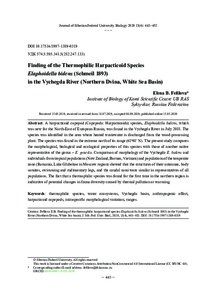Показать сокращенную информацию
Находка теплолюбивого вида гарпактикоиды Elaphoidella bidens (Schmeil 1893) в р. Вычегда (бассейн Северной Двины Белого моря)
| Автор | Фефилова, Е.Б. | ru_RU |
| Автор | Fefilova, Elena B. | en |
| Дата внесения | 2020-05-25T02:50:18Z | |
| Дата, когда ресурс стал доступен | 2020-05-25T02:50:18Z | |
| Дата публикации | 2020-05 | |
| URI (для ссылок/цитирований) | https://elib.sfu-kras.ru/handle/2311/135263 | |
| Аннотация | В июле 2018 г. в р. Вычегда в районе сброса подогреваемых сточных вод очистных сооружений лесоперерабатывающего предприятия был найден новый для северо-востока европейской части России вид гарпактикоиды (Copepoda: Harpacticoida) – Elaphoidella bidens. Вид найден в крайних северных пределах своего основного ареала (на 61°48′ с.ш.). Приведены его морфологические, биологические и экологические особенности в сравнении с другим, аборигенным, представителем рода – E. gracilis. Сравнение морфологии вычегодской E. bidens и особей из популяций тропических областей (Новая Зеландия, Борнео, Вьетнам) и умеренной зоны (Румыния, оз. Глубокое в Московской области) показало, что строение антенн, сегментов тела, плавательных и рудиментарных конечностей и каудальных ветвей оказались общими для представителей всех популяций. Находка термофильного вида впервые в северном регионе показательна с точки зрения фиксации потенциальных изменений разнообразия фауны при тепловом загрязнении или потеплении | ru_RU |
| Аннотация | A harpacticoid copepod (Copepoda: Harpacticoida) species, Elaphoidella bidens, which was new for the North-East of European Russia, was found in the Vychegda River in July 2018. The species was identified in the area where heated wastewater is discharged from the wood-processing plant. The species was found in the extreme north of its range (61°48′ N). The present study compares the morphological, biological and ecological properties of this species with those of another native representative of the genus – E. gracilis. Comparison of morphology of the Vychegda E. bidens and individuals from tropical populations (New Zealand, Borneo, Vietnam) and populations of the temperate zone (Romania, Lake Glubokoe in Moscow region) showed that the structures of their antennae, body somites, swimming and rudimentary legs, and the caudal rami were similar in representatives of all populations. The fact that a thermophilic species was found for the first time in the northern region is indicative of potential changes in fauna diversity caused by thermal pollution or warming | en |
| Язык | ru | ru_RU |
| Издатель | Сибирский федеральный университет. Siberian Federal University | en |
| Тема | термофильный вид | ru_RU |
| Тема | водные экосистемы | ru_RU |
| Тема | Вычегодский бассейн | ru_RU |
| Тема | антропогенное влияние | ru_RU |
| Тема | гарпактикоиды | ru_RU |
| Тема | внутривидовая морфологическая изменчивость | ru_RU |
| Тема | ареалы | ru_RU |
| Тема | thermophilic species | en |
| Тема | water ecosystems | en |
| Тема | Vychegda basin | en |
| Тема | anthropogenic effect | en |
| Тема | harpacticoid copepods | en |
| Тема | intraspecific morphological variation, ranges | en |
| Название | Находка теплолюбивого вида гарпактикоиды Elaphoidella bidens (Schmeil 1893) в р. Вычегда (бассейн Северной Двины Белого моря) | ru_RU |
| Альтернативное название | Finding of the Thermophilic Harpacticoid Species Elaphoidella bidens (Schmeil 1893) in the Vychegda River (Northern Dvina, White Sea Basin) | en |
| Тип | Journal Article | ru_RU |
| Контакты автора | Фефилова, Е.Б.: Институт биологии Коми научного центра УрО РАН Российская Федерация, Сыктывкар | ru_RU |
| Контакты автора | Fefilova, Elena B.: Institute of Biology of Komi Scientific Centre UB RAS Syktyvkar, Russian Federation; fefilova@ib.komisc.ru; ORCID: 0000-0001-9329-3030 | en |
| Страницы | 443–452 | |
| DOI | 10.17516/1997-1389-0319 | |
| Журнал | Журнал Сибирского федерального университета.Биология. Journal of Siberian Federal University.Biology 2020 | en |

